The largest constellations in the sky are Hydra, Virgo, Ursa Major, Cetus and Hercules. The largest northern constellations are Ursa Major, Hercules, Pegasus, Draco and Leo, and the southern ones are Hydra, Virgo, Cetus, Eridanus and Centaurus.
All these are Greek constellations, listed by Ptolemy in his Almagest in the 2nd century AD. They have been known since ancient times. The largest constellation that has not been known since antiquity is Lynx, which was created by the Polish astronomer Johannes Hevelius in the 17th century. Lynx is the 28th constellation in size with an area of 545 square degrees.
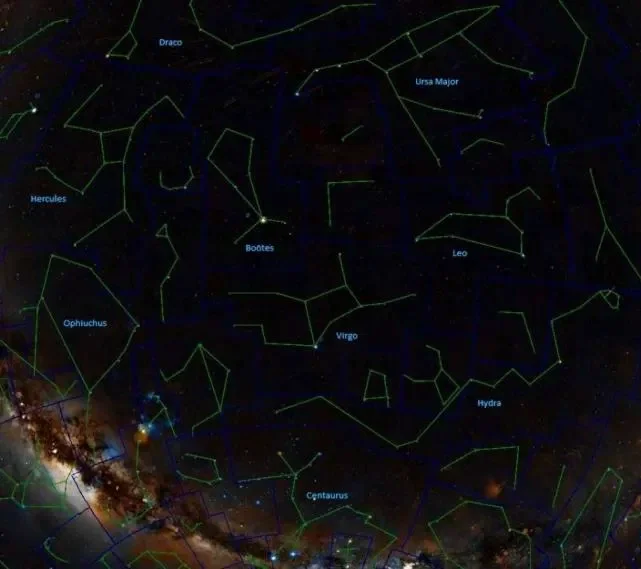
Largest constellations, image: Wikisky
Hydra, the largest of the 88 modern constellations, measures 1303 square degrees and has the shape of a twisting snake that stretches from Cancer in the north to Libra and Centaurus in the south. In spite of its size, Hydra is not particularly prominent or easily recognizable. Its brightest star, the orange giant Alphard, has an apparent magnitude of 2.0, which makes it only moderately bright.
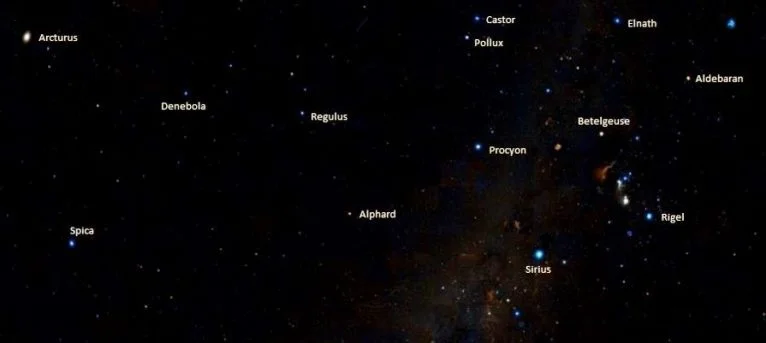
Alphard in Hydra and other bright stars in the vicinity, image: Wikisky
Virgo is much easier to find than Hydra because it is home to Spica, the 16th brightest star in the sky. Spica can be located by following the arc of the Big Dipper‘s handle. After Arcturus, it is the first bright star along the imaginary line.
Ursa Major, the largest northern constellation, is one of the most recognizable constellations in the sky. The Big Dipper asterism makes it easy for northern observers to find at any time of year. Six of the stars that form the asterism are of second magnitude and easily seen even in less than ideal conditions. Ursa Major is circumpolar to northern observers, which means that it never sets below the horizon. However, it remains mostly invisible to observers living south of latitude 30°S.
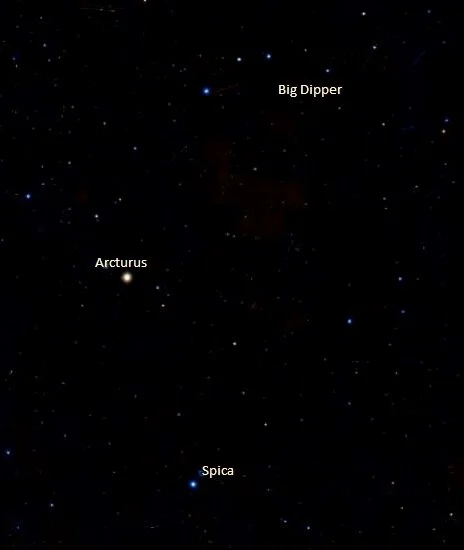
Finding Arcturus and Spica using the bright stars of the Big Dipper, image: Wikisky
Like Hydra, Cetus is large, but not particularly prominent. Its brightest star, the orange giant Diphda (also known as Deneb Kaitos), has a visual magnitude of 2.02, which makes it slightly fainter than Alphard.
Hercules, the second largest northern constellation, is considerably easier to spot, as some of its stars form an asterism known as the Keystone, which marks Hercules’ torso. However, the constellation does not have any first or second magnitude stars. Its brightest star, Kornephoros, is a yellow giant with an apparent magnitude of 2.8.
Eridanus, the sixth largest constellation, is home to Achernar, the ninth brightest star in the sky. Achernar marks the end of the celestial river and is located at the southern end of Eridanus. The constellation’s northern end borders with Orion and Taurus.
Pegasus is easy to recognize because it is dominated by a prominent asterism known as the Great Square. The Great Square of Pegasus is formed by three bright stars in Pegasus — Scheat, Markab and Algenib — and Alpheratz, the brightest star in the neighbouring Andromeda.
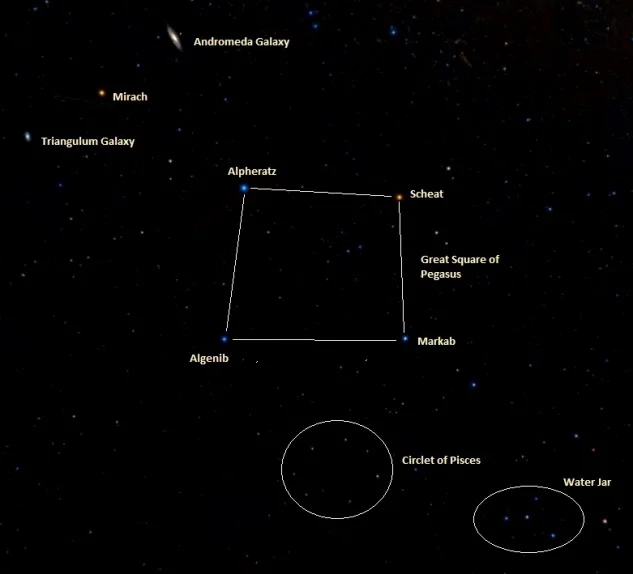
The Great Square of Pegasus, the Circlet of Pisces and the Water Jar, image: Wikisky
Draco is located in the far northern sky. Like Ursa Major, it is circumpolar and never sets for northern observers. It is not a particularly bright constellation, but it can be found between the more recognizable Ursa Major, Ursa Minor, Hercules and Cygnus. The brightest star in Draco, the orange giant Eltanin, has an apparent magnitude of 2.23. The constellation is mostly invisible to observers south of latitude 15°S.
Centaurus, the ninth largest constellation, is located in the southern sky and cannot be seen from locations north of latitude 25°N. It is one of the brightest and most recognizable southern constellations. Its brightest stars – Alpha and Beta Centauri – are the 3rd and 11th brightest stars in the sky. The stars are known as the Southern Pointers because they help observers find Crux and true south.
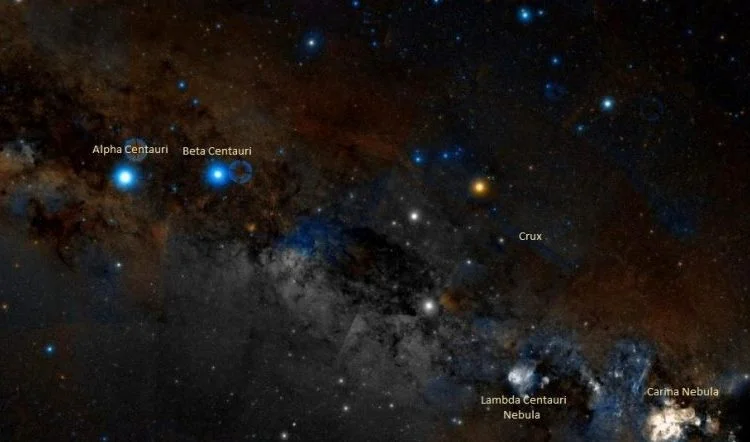
The Southern Pointers Alpha and Beta Centauri and the constellation Crux, the Southern Cross, image: Wikisky
Aquarius is relatively faint – its brightest star, Sadalsuud, a class G supergiant, has a visual magnitude of 2.87 – but can be spotted on a clear night near Pegasus and Pisces. Like other zodiac constellations, Aquarius lies on the ecliptic. It contains an asterism known as the Water Jar, from which the mythical Water Bearer pours water in a line of stars that ends with Fomalhaut, the brightest star in the constellation Piscis Austrinus, the Southern Fish, and 18th brightest star in the sky.
Ophiuchus and Leo, the 11th and 12th largest constellations, also lie on the ecliptic. Ophiuchus, the Serpent Bearer, borders Hercules on the northern end and Sagittarius and Scorpius on the southern. Its brightest star, Rasalhague, is a binary system with an apparent magnitude of 2.07. Ophiuchus divides the constellation Serpens into two parts – Serpens Caput and Serpens Cauda – representing the Serpent‘s head and tail.
Leo, the fifth largest northern constellation, is much easier to identify, with the bright Regulus (mag. 1.39) marking the Lion’s heart, Denebola (mag. 2.11) its tail and an asterism known as the Sickle representing its mane and shoulders. The Sickle looks like a backward question mark and is quite prominent in the spring sky. Regulus, located at the base of the question mark, is part of the Spring Triangle, a large spring asterism also formed by the bright stars Arcturus and Spica, which makes it even easier to locate Leo in the evening sky.
Below is the list of all 88 modern constellations ordered by size, from largest to smallest.
| Constellation | Size (area in square degrees) | Quadrant |
| 1. Hydra | 1302.844 | SQ2 |
| 2. Virgo | 1294.428 | SQ3 |
| 3. Ursa Major | 1279.660 | NQ2 |
| 4. Cetus | 1231.411 | SQ1 |
| 5. Hercules | 1225.148 | NQ3 |
| 6. Eridanus | 1137.919 | SQ1 |
| 7. Pegasus | 1120.794 | NQ4 |
| 8. Draco | 1082.952 | NQ3 |
| 9. Centaurus | 1060.422 | SQ3 |
| 10. Aquarius | 979.854 | SQ4 |
| 11. Ophiuchus | 948.340 | SQ3 |
| 12. Leo | 946.964 | NQ2 |
| 13. Boötes | 906.831 | NQ3 |
| 14. Pisces | 889.417 | NQ1 |
| 15. Sagittarius | 867.432 | SQ4 |
| 16. Cygnus | 803.983 | NQ4 |
| 17. Taurus | 797.249 | NQ1 |
| 18. Camelopardalis | 756.828 | NQ2 |
| 19. Andromeda | 722.278 | NQ1 |
| 20. Puppis | 673.434 | SQ2 |
| 21. Auriga | 657.438 | NQ2 |
| 22. Aquila | 652.473 | NQ4 |
| 23. Serpens | 636.928 | NQ3 |
| 24. Perseus | 614.997 | NQ1 |
| 25. Cassiopeia | 598.407 | NQ1 |
| 26. Orion | 594.120 | NQ1 |
| 27. Cepheus | 587.787 | NQ4 |
| 28. Lynx | 545.386 | NQ2 |
| 29. Libra | 538.052 | SQ3 |
| 30. Gemini | 513.761 | NQ2 |
| 31. Cancer | 505.872 | NQ2 |
| 32. Vela | 499.649 | SQ2 |
| 33. Scorpius | 496.783 | SQ3 |
| 34. Carina | 494.184 | SQ2 |
| 35. Monoceros | 481.569 | NQ2 |
| 36. Sculptor | 474.764 | SQ1 |
| 37. Phoenix | 469.319 | SQ1 |
| 38. Canes Venatici | 465.194 | NQ3 |
| 39. Aries | 441.395 | NQ1 |
| 40. Capricornus | 413.947 | SQ4 |
| 41. Fornax | 397.502 | SQ1 |
| 42. Coma Berenices | 386.475 | NQ3 |
| 43. Canis Major | 380.118 | SQ2 |
| 44. Pavo | 377.666 | SQ4 |
| 45. Grus | 365.513 | SQ4 |
| 46. Lupus | 333.683 | SQ3 |
| 47. Sextans | 313.515 | SQ2 |
| 48. Tucana | 294.557 | SQ4 |
| 49. Indus | 294.006 | SQ4 |
| 50. Octans | 291.045 | SQ4 |
| 51. Lepus | 290.291 | SQ1 |
| 52. Lyra | 286.476 | NQ4 |
| 53. Crater | 282.398 | SQ2 |
| 54. Columba | 270.184 | SQ1 |
| 55. Vulpecula | 268.165 | NQ4 |
| 56. Ursa Minor | 255.864 | NQ3 |
| 57. Telescopium | 251.512 | SQ4 |
| 58. Horologium | 248.885 | SQ1 |
| 59. Pictor | 246.739 | SQ1 |
| 60. Piscis Austrinus | 245.375 | SQ4 |
| 61. Hydrus | 243.035 | SQ1 |
| 62. Antlia | 238.901 | SQ2 |
| 63. Ara | 237.057 | SQ3 |
| 64. Leo Minor | 231.956 | NQ2 |
| 65. Pyxis | 220.833 | SQ2 |
| 66. Microscopium | 209.513 | SQ4 |
| 67. Apus | 206.327 | SQ3 |
| 68. Lacerta | 200.688 | NQ4 |
| 69. Delphinus | 188.549 | NQ4 |
| 70. Corvus | 183.801 | SQ3 |
| 71. Canis Minor | 183.367 | NQ2 |
| 72. Dorado | 179.173 | SQ1 |
| 73. Corona Borealis | 178.710 | NQ3 |
| 74. Norma | 165.290 | SQ3 |
| 75. Mensa | 153.484 | SQ1 |
| 76. Volans | 141.354 | SQ2 |
| 77. Musca | 138.355 | SQ3 |
| 78. Triangulum | 131.847 | NQ1 |
| 79. Chamaeleon | 131.592 | SQ2 |
| 80. Corona Australis | 127.696 | SQ4 |
| 81. Caelum | 124.865 | SQ1 |
| 82. Reticulum | 113.936 | SQ1 |
| 83. Triangulum Australe | 109.978 | SQ3 |
| 84. Scutum | 109.114 | SQ4 |
| 85. Circinus | 93.353 | SQ3 |
| 86. Sagitta | 79.932 | NQ4 |
| 87. Equuleus | 71.641 | NQ4 |
| 88. Crux | 68.447 | SQ3 |